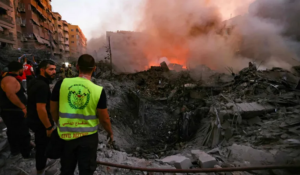Israel has changed its security outlook and now finds itself in a dangerous illusion

The rubble of a building destroyed in an Israeli airstrike in Beirut, 27 September 2024
Yagil Levy writes in Haaretz on 1 October 2024:
IDF Chief of Staff Herzl Halevi’s statement opposing a cease-fire in Lebanon, on the grounds that the army has “for years waited for this opportunity to attack Hezbollah,” is a distillation of Israel’s new security outlook. It holds that enemies are only neutralized by military means that dismantle or “diminish” their capacity to fight. Dismantling enmity by diplomatic means is not considered.
But it’s not such a new perspective. From the time of its establishment until the 2000s, Israel didn’t undertake to dismantle its enemies’ military power, and until Israel’s 1979 peace treaty with Egypt, it also refrained from doing so through diplomatic means. Israel responded militarily (retaliation), took preventive action only when the threat was immediate (the Six-Day War) and on more than one occasion exacerbated border conflicts to justify all-out war (wars of choice in the 1956 Sinai Campaign and the First Lebanon war).
Initiated military action to dismantle the enemy’s power was only carried out in the form of the Begin Doctrine – that Israel wouldn’t permit a hostile country to acquire nuclear weapons. It was on that basis that Israel twice attacked nuclear reactors – in 1981 in Iraq and in 2007 in Syria – and acted to foil Iran’s nuclear project through diplomatic means (the world powers’ 2015 agreement).
The turning point occurred with the so-called War Between the Wars, a strategy primarily associated with former IDF Chief of Staff Gadi Eisenkot, which aimed at making war a more distant prospect by preventing the enemy from using “quality weaponry” to bolster its strength. In other words, this meant wide scale regional demilitarization that would ban weaponry that could endanger Israel. IDF Chief of Staff Aviv Kochavi upgraded the concept with the doctrine of preemptive war.
The War Between the Wars worked on an initiated basis against the enemy. Israel expanded the geographic boundaries from Lebanon to Iraq and ultimately also to Iran. The old goals were expanded – from preventing the transfer of weaponry to Lebanon to the campaign against Iran.
Nearly all of that took place under the public’s radar and without thorough strategic debate. The transition to an initiated step was fed through a circular process. The political approach in the era of Benjamin Netanyahu – refraining from seeking to settle military conflicts diplomatically – encouraged the army to develop technological means to avoid war and without exposing combat troops to risk. As long as the War Between the Wars showed tactical results, the more the pressure was eased on the politicians to resort to diplomacy, and the army was encouraged to step up the fighting and so forth.
That cycle was purportedly shattered on October 7, which revealed the failures of the Israeli illusion that it could perpetually manage the conflict, while in practice, the opposite had occurred. Israeli public discourse has retrospectively been expressing an intolerance for steps that reconciled Israel to an enemy that was getting stronger (Hamas and Hezbollah).
Israelis are ignoring a simple assumption that they had previously recognized: that after a military campaign ends, the enemy rebuilds its military capabilities. For example, no one blamed Golda Meir in 1973 for not engaging in a preemptive war prior to the Yom Kippur War against an Egypt that had become stronger.
On the right and the left, the expectation implied in the discourse is that Israel would launch a preemptive war as long as the enemy was getting stronger and won’t try to deal diplomatically to avoid war by other means.
So the illusion is that Israel would miss the opportunity now to prevent Hezbollah’s defeat and to gradually expand the goals of the war in Lebanon, if Israel’s advantage permits it to do so. It’s only the world that is capable of freeing us from such an illusion.
This article is reproduced in its entirety
